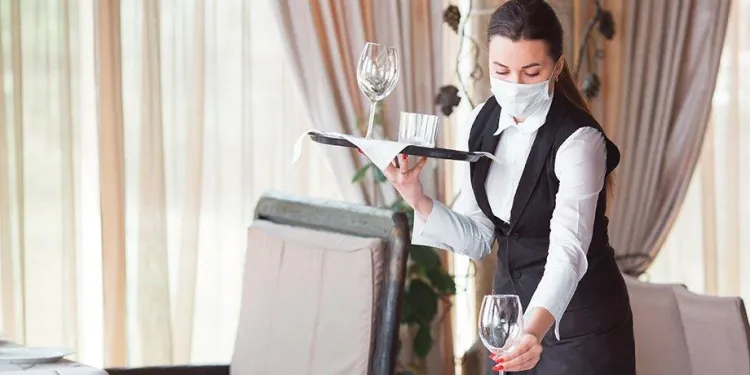News & Events

HOW TECHNOLOGY CAN ELEVATE GUEST SERVICES AND THEIR SECURITY
Sumber : SourceSecurity.com
Edition, May 2021
The return to the workplace is a focal point for many in the built environment but one of the most important elements is easy to overlook. Guest services will be vital in the return to the workplace. Front-of-house teams will be responsible for welcoming building users back and reassuring them as they negotiate shared spaces in the post-Covid era.
The workplace will inevitably look different after Covid. We have become more aware of our spaces, how clean they are, and what spaces building users share. Employees have also become more conscious of the pros and cons of the workplace. For some, a year of working from home has been a welcome break from the stress and time taken by a commute.
Many organisations are considering moving to hybrid workplace approaches, downsizing their corporate real estate portfolio, and using shared spaces more consciously, be that for focused quiet work or collaboration. We will also see heightened care in workplace cleaning and more data-led solutions. Front-of-house teams will be at the centre of helping building users get used to these changes.
Front-of-house personnel will likely be responsible for ensuring buildings do not exceed safe occupancy levels and will be aided by visitor management systems.
Another change to look out for in the workplace will be the use of technology. Tech-led organisations have long reminded us that gut instinct and trusting our senses is not enough anymore, but Covid-19 has forced us to come to terms with this.
Now that adopting technology has become crucial in cleaning, we will see a reticence to adopt it elsewhere fade too. A survey from McKinsey suggests that the pandemic has accelerated the adoption of technologies by several years.
Why is this important for guest services? Much like other workplace changes, new technologies will alter how building users interact with their environment. Tech will also enable front-of-house teams to focus on the key ingredient of their role – human interaction. This will be vital in helping occupants feel comfortable, safe, and happy.
These systems have been around in the workplace for many years, and pre-Covid were used to help us maximise our space and utilisation. These systems are even more important as we are likely to see some return to the workplace before everyone has been vaccinated. We may see systems that contact only those occupants in an affected area of a building, rather than a whole workforce, to limit worry and ensure most people can remain confident in the hygiene of their workspace.
For the rest of 2021 at least, precautions such as social distancing will need to be in place. Workplaces will continue to function at limited occupancy for some time to keep people safe. Front-of-house personnel will likely be responsible for ensuring buildings do not exceed safe occupancy levels and will be aided by visitor management systems. These may be used by individual organisations or by multi-tenanted buildings.
Organisations are mitigating risks where possible. Handheld digital thermometers have been in high demand. The use of such devices has reshaped the role of security officers over the past year. Officers have become familiar faces in shops and shared spaces, keeping people safe and acting as the first point of contact.
The security sector has been placed under immense pressure, balancing the need to enforce precautions with responding to stressed building users in an empathetic way. Officers have demonstrated agility that security technology cannot replace. Post-pandemic, we will likely see a greater appreciation for what manned guarding can offer and a greater potential for officers in front of house roles.
Some organisations may choose to increase the collaboration between their front-of-house and security teams. This could include implementing identity verification systems, as well as touchless systems. This will allow the focus of front-of-house teams to remain on the people and giving a warm welcome to users as they return to the office.
Monitoring solutions may be the first things that come to mind when discussing security technology. We have seen an increasing trend toward integrating remote monitoring with manned guarding since before the pandemic. Such a move may be even more important now.
For many organisations, the pandemic has forced a rapid switch in focus. Organisations have had to face the security challenges of caring for vacant premises and the additional complications of managing cybersecurity for remote work. Rebalancing the cost and focus of security may feel as though it has left some businesses without the capacity to utilise front-ofhouse officers. Yet when employees return to the workplace, front-of-house teams will be more important than ever.
For those that did not do so during the pandemic, now is the time to be investing in effective monitoring solutions. The falling cost of technology means such a solution can be combined with manned guarding and front-of-house roles. Organisations may need to invest in fewer officers, but their roles can be more focused upon the occupant experience.
Beyond keeping employees safe, guest services are going to play a central role in making the workplace an attractive option. Remote working has had both pros and cons but many of those downsides will be diminished with the end of the pandemic. Loneliness will no longer be such a challenge when seeing friends and neighbours is an option, and the return of children and partners to school and work will relieve distractions.
It may be tempting, then, for many employees to continue working from home. As a result, many opportunities for collaborative work will be lost. For employers looking to encourage their workforce to return, creating an amazing workplace experience is key. Technology alone can’t offer this. Rather, too much tech could create an environment that feels clinical and impersonal. Use technology to streamline the boring or stressful elements of the workplace and invest in friendly faces who will welcome your workforce back.
Edition, May 2021
The return to the workplace is a focal point for many in the built environment but one of the most important elements is easy to overlook. Guest services will be vital in the return to the workplace. Front-of-house teams will be responsible for welcoming building users back and reassuring them as they negotiate shared spaces in the post-Covid era.
The workplace will inevitably look different after Covid. We have become more aware of our spaces, how clean they are, and what spaces building users share. Employees have also become more conscious of the pros and cons of the workplace. For some, a year of working from home has been a welcome break from the stress and time taken by a commute.
Many organisations are considering moving to hybrid workplace approaches, downsizing their corporate real estate portfolio, and using shared spaces more consciously, be that for focused quiet work or collaboration. We will also see heightened care in workplace cleaning and more data-led solutions. Front-of-house teams will be at the centre of helping building users get used to these changes.
The Role of Technology
Front-of-house personnel will likely be responsible for ensuring buildings do not exceed safe occupancy levels and will be aided by visitor management systems.
Another change to look out for in the workplace will be the use of technology. Tech-led organisations have long reminded us that gut instinct and trusting our senses is not enough anymore, but Covid-19 has forced us to come to terms with this.
Now that adopting technology has become crucial in cleaning, we will see a reticence to adopt it elsewhere fade too. A survey from McKinsey suggests that the pandemic has accelerated the adoption of technologies by several years.
Why is this important for guest services? Much like other workplace changes, new technologies will alter how building users interact with their environment. Tech will also enable front-of-house teams to focus on the key ingredient of their role – human interaction. This will be vital in helping occupants feel comfortable, safe, and happy.
Occupancy and Visitor Management Systems
These systems have been around in the workplace for many years, and pre-Covid were used to help us maximise our space and utilisation. These systems are even more important as we are likely to see some return to the workplace before everyone has been vaccinated. We may see systems that contact only those occupants in an affected area of a building, rather than a whole workforce, to limit worry and ensure most people can remain confident in the hygiene of their workspace.
For the rest of 2021 at least, precautions such as social distancing will need to be in place. Workplaces will continue to function at limited occupancy for some time to keep people safe. Front-of-house personnel will likely be responsible for ensuring buildings do not exceed safe occupancy levels and will be aided by visitor management systems. These may be used by individual organisations or by multi-tenanted buildings.
Temperature Checks and Identity Verification Systems
Organisations are mitigating risks where possible. Handheld digital thermometers have been in high demand. The use of such devices has reshaped the role of security officers over the past year. Officers have become familiar faces in shops and shared spaces, keeping people safe and acting as the first point of contact.
The security sector has been placed under immense pressure, balancing the need to enforce precautions with responding to stressed building users in an empathetic way. Officers have demonstrated agility that security technology cannot replace. Post-pandemic, we will likely see a greater appreciation for what manned guarding can offer and a greater potential for officers in front of house roles.
Some organisations may choose to increase the collaboration between their front-of-house and security teams. This could include implementing identity verification systems, as well as touchless systems. This will allow the focus of front-of-house teams to remain on the people and giving a warm welcome to users as they return to the office.
Using Monitoring to Make Guest Services More Available
Monitoring solutions may be the first things that come to mind when discussing security technology. We have seen an increasing trend toward integrating remote monitoring with manned guarding since before the pandemic. Such a move may be even more important now.
Beyond keeping employees safe, guest services are going to play a central role in making the workplace an attractive option.
For many organisations, the pandemic has forced a rapid switch in focus. Organisations have had to face the security challenges of caring for vacant premises and the additional complications of managing cybersecurity for remote work. Rebalancing the cost and focus of security may feel as though it has left some businesses without the capacity to utilise front-ofhouse officers. Yet when employees return to the workplace, front-of-house teams will be more important than ever.
For those that did not do so during the pandemic, now is the time to be investing in effective monitoring solutions. The falling cost of technology means such a solution can be combined with manned guarding and front-of-house roles. Organisations may need to invest in fewer officers, but their roles can be more focused upon the occupant experience.
Encouraging Employees Back.
Beyond keeping employees safe, guest services are going to play a central role in making the workplace an attractive option. Remote working has had both pros and cons but many of those downsides will be diminished with the end of the pandemic. Loneliness will no longer be such a challenge when seeing friends and neighbours is an option, and the return of children and partners to school and work will relieve distractions.
It may be tempting, then, for many employees to continue working from home. As a result, many opportunities for collaborative work will be lost. For employers looking to encourage their workforce to return, creating an amazing workplace experience is key. Technology alone can’t offer this. Rather, too much tech could create an environment that feels clinical and impersonal. Use technology to streamline the boring or stressful elements of the workplace and invest in friendly faces who will welcome your workforce back.




